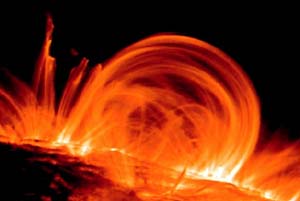| 2004 |

|
YEAR BOOK |
Armagh Observatory, Armagh
|
Studying solar transient events from Armagh
|

Super-flares with eruptions up to 10 million times more powerful than anything ever recorded from the Sun are detected from distant stars which appear to be just like the Sun. If the Sun had such an eruption, it would cause mass extinctions, plunge the Earth into a heat wave, flood the planet with gamma and X-rays, melt electronics in orbiting satellites, cause global auroras, and wipe out all of the ozone that protects the Earth from harmful ultraviolet radiation. Thankfully, there is no evidence that our Sun has ever had such eruptions.
Over the past decade, the uninterrupted, high-resolution coverage of the Sun, both from the excellent range of telescopes aboard many spacecraft and from ground-based instruments, has led to a wealth of observations and knowledge of small-scale dynamic regions just above the visible surface, known as the chromosphere, to the transition region and corona. Since many of these events have been observed with different instruments, they show different properties from one another. It is suggested that many of these phenomena result from small-scale magnetic reconnection events due to the continually evolving magnetic fields that are seen at the photospheric level, although waves are thought to play an important heating role as well. Nowadays, there is a general consensus that the key to understanding how the solar plasma is accelerated and heated may well be found in studies of these small-scale dynamic events.
While it has been well established for decades that the corona and solar wind owe their existence to coronal heating, the detailed heating process itself remains unknown. Indeed, observations of the solar atmosphere outside active regions have led to the increasing recognition that the chromosphere, transition region and corona of the Sun are threaded with an incredible amount of small-scale, highly dynamic structures, many of which have a profound effect on the local dynamics, energy flow and radiative transfer. Solar physicists from Armagh Observatory are actively involved in a range of satellite missions, coupled with computer modelling, in an effort to better understand these transient events, and hence the mechanisms of coronal heating.
Contact: Professor Gerry Doyle, Armagh Observatory, Armagh; E-mail: [email protected]